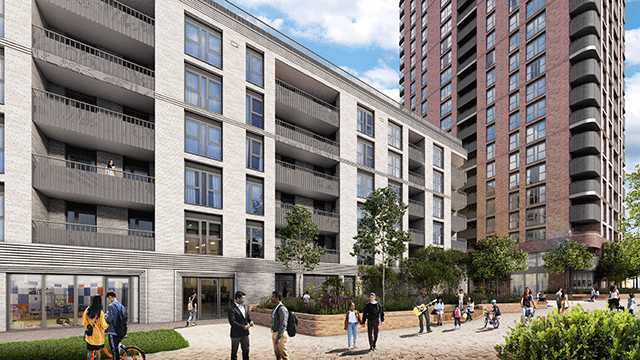Town and country planning – Planning permission – Condition – Claimant applying to quash decision of inspector upholding refusal of planning permission for occupational worker’s dwelling – Inspector determining proposal was not “building for agriculture” and amounted to inappropriate development within green belt – Whether inspector erring in failing to consider proposed planning condition restricting occupancy to agricultural worker – Application dismissed
The claimant applied for planning permission for a development at “Hookmeadow”, Philpot Lane, in Chobham. The site was in the metropolitan green belt, in open countryside outside the settlement boundary. The proposal was for the erection of an occupational worker’s dwelling ancillary to use of the land for horticultural and agricultural purposes and a single-storey extension to form an enlarged bedroom.
The second defendant local authority dismissed the application. An inspector appointed by the first defendant secretary of state dismissed the claimant’s appeal against that refusal under section 78 of the Town and Country Planning Act 1990. The defendant had provided a schedule of conditions for the inspector to consider if he disagreed with its contention that planning permission should be refused, including a condition to restrict the occupancy of the dwelling to a person working in agriculture on the land. The inspector found that the proposed dwelling was not a “building for agriculture” within the relevant category of exception in para 89 of the National Planning Policy Framework (NPPF) and amounted to inappropriate development in the green belt.
The claimant applied to challenge the inspector’s decision under section 288 of the 1990 Act which was twice refused. However, the Court of Appeal granted permission to apply for a planning statutory review under CPR rule 52.10(5) and ordered that the Court of Appeal should determine that application itself under CPR rule 52.10(6).
The claimant contended that: the inspector had: (i) failed to have regard to the proposed agricultural occupancy condition; (ii) acted in breach of the rules of natural justice by failing to give her the opportunity to show that the condition was reasonable; and (iii) failed to provide lawful reasons for rejecting the condition.
Held: The application was dismissed.
(1) The central question was whether, on the evidence before him, the inspector was entitled lawfully to find, essentially as a matter of fact and degree, that the development for which planning permission was being retrospectively sought by the claimant was not a “building for agriculture” within the relevant category of exception in paragraph 89 of the NPPF which led to the conclusion that it was, therefore, inappropriate development in the green belt. If the crucial findings of fact generating that conclusion were lawfully made, the inspector was not required to consider the imposition of a condition to control the occupancy of the building on the assumption, contrary to those findings, that it was, or would in the future become, a “building for agriculture”. Contrary to the case presented to him by the claimant, the inspector found, as he was entitled to find, that the development for which retrospective planning permission had been sought was not, in fact, a building for agriculture within the relevant exception in para 89.
It followed that the inspector was entitled, and right, not to take the suggested agricultural occupancy condition into account when determining the appeal. Logically and legally, the condition did not fall to be considered until it was first established that the proposed development was a building for agriculture. Only then could a condition restricting occupancy to an agricultural worker be regarded as consistent with the principle that a planning condition must fairly and reasonably relate to the development permitted. But the condition had no bearing on the prior question of whether the dwelling on the site truly was a building for agriculture. The need to impose an agricultural occupancy condition did not, therefore, arise.
The inspector, though obviously aware of it, did not act unlawfully by omitting to have regard to it in making his decision. He was not required to take into account a condition that was incompatible with the proposal before him. Therefore, the inspector’s approach was both realistic and correct. Given his findings of fact and conclusions in the light of the cases advanced at the hearing, he did not have to consider granting a planning permission that would be effective only upon a future change of use neither proposed nor even in prospect.
(2) It was normal practice for inspectors determining planning appeals to consider, with the help of the parties, whether conditions should be imposed on any grant of planning permission, and what conditions might be suitable. In this case the inspector had included “conditions” in his hearing agenda. The claimant had been represented at the hearing by experienced counsel. And it could not be said that she was unaware of the need to make any comment she wanted to make on the suggested agricultural occupancy condition. The condition was discussed at the hearing, the claimant had a fair opportunity to state her position and she had taken that opportunity. The inspector would have been familiar with the government’s advice on the tests for planning conditions in the Planning Practice Guidance and drawing it to his attention would not have made any difference to his decision.
(3) In the circumstances of this case, there was no obligation on the inspector to explain in his decision letter why he was not granting planning permission for the proposal before him subject to an agricultural occupancy condition. The requirement for intelligible and adequate reasons why the claimant’s appeal was dismissed, and identifying the inspector’s conclusions on the principal important controversial issues, had been satisfied. On a fair reading of the decision letter itself, there was no room for genuine doubt about the basis for the decision. In his costs decision the inspector also explained why he had disregarded the condition. That he did succinctly, in terms corresponding to the findings and conclusions in the decision letter itself. The statement that it “would not be reasonable to change and then restrict the use of the building to agriculture by condition” was an obvious corollary of the conclusions on which he based his decision to dismiss the appeal and it was not irrational.
Ashley Bowes (instructed by Leigh Day) appeared for the claimant; Cain Ormondroyd (instructed by the Government Legal Department) appeared for the first defendant; Ned Westaway (instructed by Surrey Heath Borough Council) appeared for the second defendant.
Eileen O’Grady, barrister






